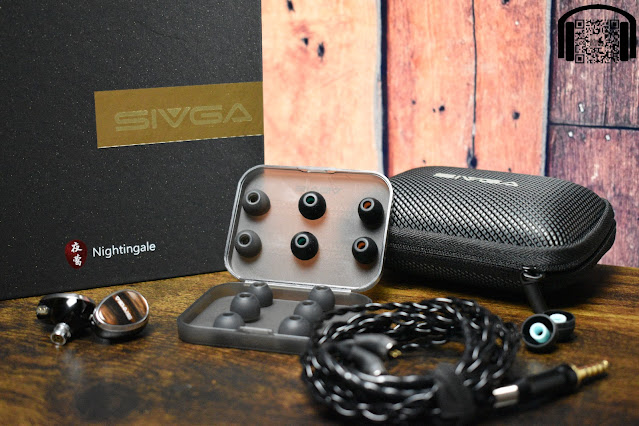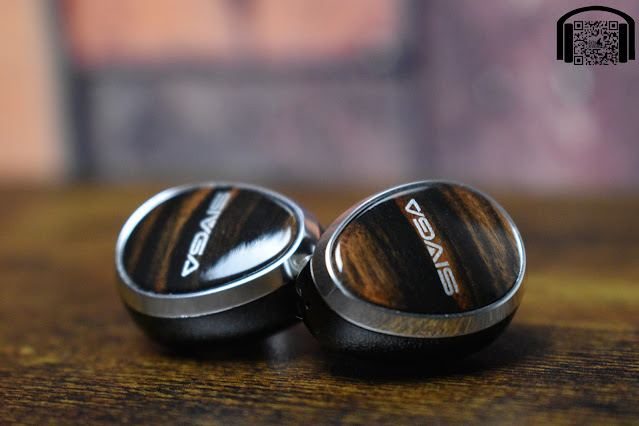- Get link
- X
- Other Apps
English | Español
TLDR version on YouTube: TDLR - Sivga Nightingale
The Nightingale have been sent to me directly by Sivga for me to share my impressions and thoughts in this review. They have not made any specific requests and I will do my best to be as sincere and unbiased as humanly possible.
You can find the official Sivga page for the Nightingale here: https://www.sivgaaudio.com/product_d?id=17
As always, this is a non-affiliate link, meaning I do not receive anything in exchange for clicks or purchases made.
To avoid being repetetive in my reviews, you can find all the info about how I create the reviews, equipment used, how I receive the products and how to interpret my reviews by visiting: About my reviews
Intro…
This is the first set of Sivga IEMs that I have tried. They do have a few other models but these are their latest release, and feature a 14.5mm Planar driver, which I believe is their first entry into the planar IEM world.
I am not overly sure what the street price of these IEMs is but the links they share on their official page (at the time of putting this review together) lead to them being available on Amazon US for $230 and on Aliexpress for 333€ plus 87€ shipping. So we are not talking about a budget set of IEMs here.
Having reviewed some of their headphones in the past, I know that Sivga are capable of some good stuff, usually with their own twist to it. In this case, they certainly put their own twist to but let's start from the beginning.
Presentation…
The packaging is simple but elegant. Arriving in a black box with just the brand and model on the front, along with some brief details on the back, the lid lifts off to reveal the IEMs sitting in a cutout with the storage case sitting in another cutout below. There is a velvety finish to the surrounding material that helps with the elegance.
Opening the storage case, which I am quite fond of, we find the included 4.4mm cable, along with a plastic storage case for the additional 6 sets of tips that are included. The tips are 3 sizes of 2 different types (plus the ones installed) but I will say that they are a little on the small size. The largest size work fine for me personally but I am usually a medium (depending on tip type and IEM in question), so if you are someone with larger canals, you will need to provide tips that work better for you.
The plastic storage case for the tips is a nice touch. I do have a few of these around but this one is a little more compact and fits easily in the mesh pocket of the included transport/storage case. Speaking of the case, it is semi-rigid, more towards rigid than semi, and has a black and grey pattern to it with the Sivga logo on the top. The case is of a nice size and of good quality. I don't usually go into this much detail with included cases, so it shows that I am a fan of this one.
Build and aesthetics…
The Nightingale use a teardrop shape for the shells, with a resin interior shell and a faceplate with a wood look to it that is surrounded by a metal border. The IEMs are fairly small and, although they are not the lightest of IEMs for their size, they fit me well and caused no fatigue over longer listening sessions due to the build.
The two pin sockets are sort of recessed behind the faceplate, just slightly, which gives for a very accomplished aesthetic when they are connected. The included cable is pretty decent, with metal hardware except for the strain relief around the two pin connectors, which is black rubber but has a silver metal ring that matches the aesthetics of the IEMs.
I have to say that I am quite fond of the simple but elegant aesthetics of the IEMs and have no issues with the fit or the apparent build quality.
Sound…
I'm afraid here is where things go downhill. When listening to the Nightingale out of the box, I had flashbacks of the Audeze iSine IEMs. I'm afraid that the tuning of the Nightingale is possibly one of the worst I have come across on planar IEMs out of the box, along with the iSine.
There is a lack of bass to the tuning that is very apparent. I have said many times that I am not someone who craves excessive midbass, in fact, it gives me a headache if it is both excessive and not of great quality, however, the Nightingale is more that just lean on the bass, it is pretty absent. Even with smaller bore tips, I still found it to be way below my preferences.
But the lack of bass I can live with, a quick press of a button on an iFi device makes things much better, it is the upper mids that I find the worst on these IEMs. At 1.5kHz the tuning just rolls off and keeps rolling off until it appears back with a peak well into the treble range. This makes everything sound unclear, distant, and, well, just bad in my opinion.
I know that audio is very subjective and I am always the first to preface things with "in my opinon", "for my tastes" or "with my preferences", and I am sure that someone will enjoy the Nightingale tuning out of the box, but I think that will be a very small selection of people.
Just so you know what I am talking about, here is the graph in comparison to my usual personal target as reference:
Honestly, it looks as though they had the graph upside down when tuning these IEMs!
Usually I go through a detailed listening session with my list of test tracks (which can be found here) and mention things that I notice, always referring to the same tracks so that it is easy to compare with any of my previous reviews. However, in this case, it just isn't needed, as the things that grab my attention are all negative and I have already explained the overall picture above.
But let's get away from the negativity and talk about fixing the issues!
I mentioned the Audeze iSine above and, for those of you that don't know, it was one of the main planar offerings way before the planar boom that happened recently. I think that it was generally agreed (obviously with some exceptions as always) that it was tuned pretty terrible and needed EQ. In fact, even the manufacturer knew this and sold a specific cable with DSP inside that did the EQ and made it a pretty darn good set of IEMs, holding up to even the recent batch quite a few years later.
Well, Sivga have a set of planar IEMs that are in many ways very similar.
After spending some hours with the stock tuning, I gave up and broke out the parametric EQ, something that I very rarely do for reviews. I will sometimes play around with EQ and do some tests but I avoid using it for detailed listening sessions for reviews. Well, after some tweaking, especially in those lows and in the upper mids, the Nightingale started to come alive. In fact, it started to be a very enjoyable and good performing IEM.
After some more playing around, I started to investigate tuning it to some other FR's from other IEMs and I have to say that I am very impressed with how well this IEM performs when we take it towards other tunings.
Obviously it is great when tuned to my preference target but when tuned to other IEMs that I am fond of, it took very well to their sound signature and performed on a very good level. It was a lot of fun to take tunings that I like from budget IEMs and turn the Nightingale into a set that had that same tuning but with much better performance.
Even when I pushed its limits with some ridiculously bass heavy tunings, the Nightingale didn't seem to suffer (as long as the preamp was set correctly of course) and outperformed a lot of IEMs at their own game.
It is capable of good detail, good sound stage, good image placement, in fact, it is just a very capable IEM in the sound department, it just needs tuning.
Conclusion…
I never enjoy posting negative reviews and, to be honest, I don't feel this is a negative review in general, the only negative about this set is the tuning.
I don't score IEMs except on Head-Fi as it is obligatory, but in this case, a set of 3 out of 10 IEMs could easily become a 9 out of 10 just with some EQ applied.
Now, I understand that there are a lot of people out there that don't want to EQ, and plenty of people out there that really don't understand EQ or how to use it, but I do feel that, with the Nightingale, it is going to become an obligatory part of the chain.
The bass can easily be fixed with a bass boost on an iFi chain, or even by using an impedance adapter. In fact, there may be plenty of people out there who are ok with the bass, even I could live with it for a lot of music, but it is that huge absence in the 2 to 8kHz range that makes me say that EQ is a must with these IEMs.
They are a well built, comfortable and good looking set of IEMs that, when EQ'd, become a very good set of planar IEMs, rivaling almost all the other planar sets out there on performance, but they need that tweak to get them there.
All FR measurements of IEMs can be viewed and compared on achoreviews.squig.link
All isolation measurements of IEMs can be found on achoreviews.squig.link/isolation
To comment or contact, visit any of the following social media platforms:







